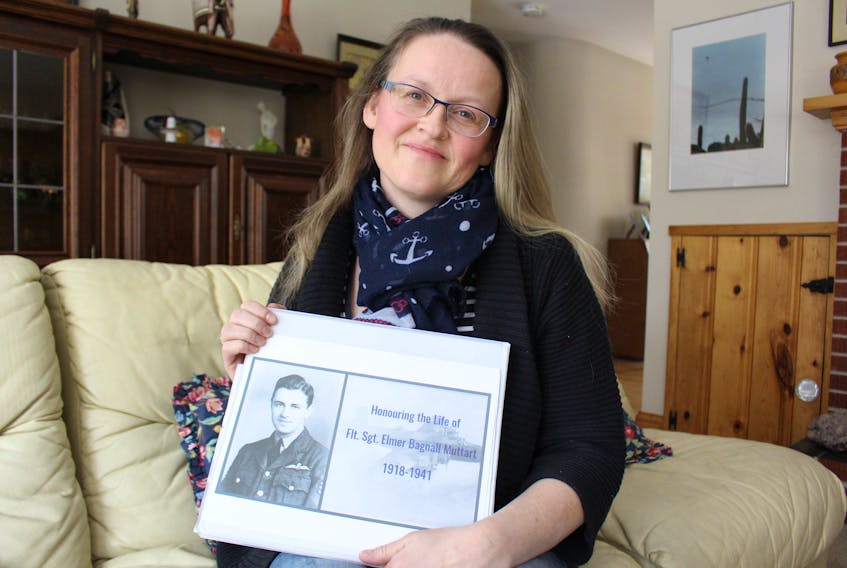NORTH TRYON – The sounds of gun fire erupted from below as Elmer Muttart continued to steer the Halifax bomber over a village in the Netherlands.
It was the middle of the Second World War and the 23-year-old’s plane was going down.
He yelled at his seven crew members to jump from the plane. Muttart stayed, flying the bomber in the pitch dark night, his plane lit with flames, before crashing in a field.
It was the ultimate sacrifice.
Remembering Elmer Bagnall Muttart
Recently, a distant relative of Muttart, Lori (Muttart) Eggert, came across a blog post written by Pieter and Daria Valkenburg which detailed Muttart’s early life and military career providing a new meaning to ‘We will Remember Them’ for Eggert. The blog, https://bordencarletonresearchproject.wordpress.com is part of the Borden-Carleton Cenotaph Research Project the Valkenburgs started in 2016.
“Because I am of Dutch descent and was also in the Air Force, Elmer’s story peaked my interest. Someone who saves their crew and a village deserves his credit. He was only 23 years old when he died, but he still managed to do a lot,” said Pieter.
Given that March 14 would be Muttart’s 100th birthday, Eggert decided to hold a celebration for the fallen soldier on Saturday, March 10, at the Borden-Carleton Royal Canadian Legion #10 from 2 to 5 p.m.
“I think his story is incredible. I get emotional thinking about him. I look at his picture and I feel like he could be my brother. It would be a missed opportunity not to honour him on his birthday,” said Eggert.
Early Life

According to the Valkenburg’s research, Muttart was born in Cape Traverse on March 14, 1918. He attended the local community school and later Horton Academy and then onto Acadia University, both in Wolfville, N.S.
After graduating with two degrees in 1939, including a Bachelor of Science in Engineering, he applied to the Air Force but was denied. He began working as a civil engineer for about seven or eight months before enlisting in the Air Force in New Brunswick in June of 1940. He travelled to Saskatoon, Sask., for pilot training and received his wings in January of 1941.
Military Career
After receiving his wings, Muttart was flown to England in early March. There he was trained in flying two-motored Whitley bombers. He flew his first time as co-pilot on May 27 as part of the 78th squadron. He flew eight more flights before being appointed first pilot in July.
He flew 12 more flights, most of which with Reg Alexander, his permanent navigator. The rest of his crew changed regularly. Muttart was later promoted to Flight Sergent and transferred to 76 Squadron in September.

He was retrained on the four-motor Hadley Page Halifax bomber.
Muttart’s Last Mission
On Oct. 12, 1941, Muttart made his 13th and final flight as first pilot with Alexander and six other crew members. Around 7:30 p.m. Muttart, his crew and about 100 other bombers left England and headed for their target: Bremen, Germany. While flying over the northern part of the Netherlands, which was under German occupation, they were met by German night fighters. Muttart’s plane was fired on around 10:15 p.m. In his attempted escape, Muttart flew south passing the town of Harlingen. There he was fired upon a second time. It was then Muttart made the decision to tell his crew to parachute to safety and he would try to pilot the plane away from the village.
“All of his crew members survived because of him. They were sent to Prisoner of War Camps after being captured by the Germans, but they survived that flight because of Elmer,” said Daria.

According to an eyewitness, who was about nine years old at the time of the crash, Muttart’s plane flew past the village of Wons, and about 40 metres over their farm, on fire, before it crashed in a nearby farm a couple of hundred metres south.
Apparently, the family of farmers and people of the village were not allowed to go to the plane and help because of German occupation. His body was recovered by German forces and he was buried a few days later in Harlingen.
Muttart is survived by his sister Helen who presently lives in Ontario.
Valkenburgs’ Efforts
Fluent in Dutch, Pieter contacted researchers in the Netherlands as well as the Missing Airmen Memorial Foundation, a non-profit organization in the Netherlands dedicated to preserving history of allied planes that were shot down during the war.
Valkenburg has been working with the organization to raise funds for a commemorative plaque to honour Elmer and his crew at the crash site.
If enough funding is secured, the plaque could be installed later in 2018. The Tryon Area Historical Society is helping with collecting donations starting the “Muttart Memorial Fund.” For more information the Valkenburgs can be contacted at [email protected].









